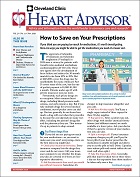Because hypertension rarely produces serious symptoms, it has been called the silent killer. Most people learn they have hypertension during a routine checkup. If you are prone to frequent headaches, get dizzy more often than you used to, have occasional nosebleeds, and notice that your heart races or beats irregularly from time to time, you may have hypertension. Have your blood pressure checked. It could be normal, or you could have pre-hypertension or hypertension.
Reducing blood pressure has been shown to reduce the risk of second stroke, regardless of type. Which class of hypertension medication is best for this purpose is still being debated. However, there is no clear evidence that one class of blood pressure medication is better than another. The key is to use whatever medication or combination of medications is necessary to bring your blood pressure into the normal range.
To read more important news and information about your hearts health, purchase the special report from Cleveland Clinics Heart Advisor,Stroke: Advances in Detection & Treatment of Cerebrovascular Disease.
To continue reading this article or issue you must be a paid subscriber. Sign in
Subscribe to Heart Advisor
Get the next year of Heart Advisor for just $20. And access all of our online content - over 2,000 articles - free of charge.
Subscribe today and save 38%. It's like getting 5 months FREE!





